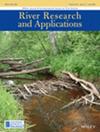Long‐term dynamics of large wood in old‐growth and second‐growth stream reaches in the Cascade Range of Oregon
IF 1.9
4区 环境科学与生态学
Q4 ENVIRONMENTAL SCIENCES
引用次数: 0
Abstract
We quantified temporal dynamics of wood storage, input, and transport over a 24‐year period in adjacent old‐growth and second‐growth forested reaches in Mack Creek, a third‐order stream in the Cascade Range of Oregon. The standing stocks of large wood in the old‐growth reach exceeded those at the second‐growth reach by more than double the number of wood pieces and triple the wood volume. Annual inputs of large wood were highly variable. Wood numbers delivered into the old‐growth reach were 3× higher and wood volume 10× greater than in the second‐growth reach. The movement of number and volume of logs did not differ significantly between the two reaches over time. Less than 2% of the logs moved in most years, and the highest proportion moved in the year of the 1996 flood (9% in old growth and 22% in second growth). Most of the large wood aggregated as jams in both reaches. The second‐growth reach lacked major jams, but 29% of the logs in the old growth were in full‐channel spanning jams. Long‐term observations of annual storage, input, and movement reveal the temporal dynamics of wood rather than static representations of the characteristics of wood. Input events and transport of wood in Mack Creek were episodic and varied greatly over the 24‐year study, which illustrates one of the major challenges and opportunities for understanding the cumulative dynamics of wood in streams.俄勒冈州喀斯喀特山脉原始森林和次生林溪流中大型木材的长期动态变化
我们对俄勒冈州喀斯喀特山脉的一条三阶溪流--麦溪中相邻的老林区和二林区的木材储存、输入和运输的时间动态进行了量化,时间跨度长达 24 年。原始森林河段的大木头蓄积量比次生林河段的大木头蓄积量高出一倍多,木块数量高出三倍。每年输入的大木头数量变化很大。进入老林区的木材数量是第二林区的 3 倍,木材体积是第二林区的 10 倍。随着时间的推移,两个河段的原木数量和体积的移动没有明显差异。大多数年份移动的原木不到 2%,1996 年洪水当年移动的原木比例最高(老林区为 9%,次生林区为 22%)。在这两个河段,大部分大木头都聚集成木块。次生河段没有大的木块,但老河段有 29% 的原木是全河道横向木块。对年度储存、输入和移动的长期观测揭示了木材的时间动态,而不是木材特性的静态表现。在长达 24 年的研究中,麦克溪的木材输入事件和运输是偶发的,而且变化很大,这说明了了解溪流中木材累积动态的主要挑战和机遇之一。
本文章由计算机程序翻译,如有差异,请以英文原文为准。
求助全文
约1分钟内获得全文
求助全文
来源期刊

River Research and Applications
环境科学-环境科学
CiteScore
4.60
自引率
9.10%
发文量
158
审稿时长
6 months
期刊介绍:
River Research and Applications , previously published as Regulated Rivers: Research and Management (1987-2001), is an international journal dedicated to the promotion of basic and applied scientific research on rivers. The journal publishes original scientific and technical papers on biological, ecological, geomorphological, hydrological, engineering and geographical aspects related to rivers in both the developed and developing world. Papers showing how basic studies and new science can be of use in applied problems associated with river management, regulation and restoration are encouraged as is interdisciplinary research concerned directly or indirectly with river management problems.
 求助内容:
求助内容: 应助结果提醒方式:
应助结果提醒方式:


